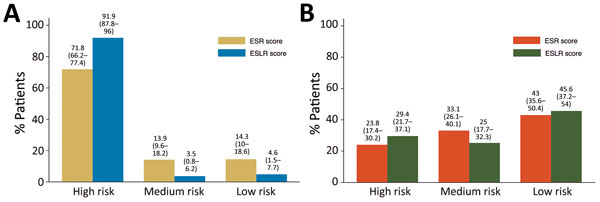Volume 23, Number 11—November 2017
Research
Symptom- and Laboratory-Based Ebola Risk Scores to Differentiate Likely Ebola Infections
Figure 2

Figure 2. Suspected Ebola patients categorized as high-, medium-, and low-risk by ESR and ESLR scores, Kerry Town Ebola treatment center, Sierra Leone, 2014–2015. A) EVD-positive patients; B) EVD-negative patients. ESLR, Ebola symptom- and laboratory-based risk; ESR, Ebola symptom-based risk. Numbers in parentheses indicate 95% CIs.
Page created: October 16, 2017
Page updated: October 16, 2017
Page reviewed: October 16, 2017
The conclusions, findings, and opinions expressed by authors contributing to this journal do not necessarily reflect the official position of the U.S. Department of Health and Human Services, the Public Health Service, the Centers for Disease Control and Prevention, or the authors' affiliated institutions. Use of trade names is for identification only and does not imply endorsement by any of the groups named above.